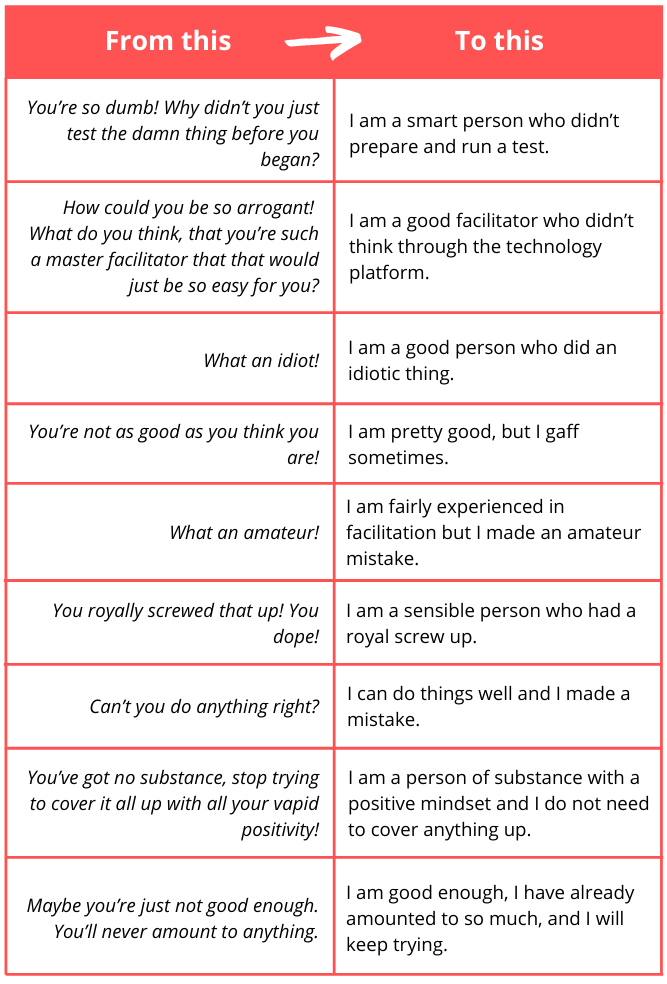Gain confidence: Defeat negative self-talk and win back your life
- Amy Jin

- Nov 30, 2020
- 8 min read

Have you failed recently? Can’t get it out of your head? Replaying bad experiences with negative self-talk can limit your future potential. Read on for how to fully process the experience, learn the lesson, and build lasting confidence. Short on time? Skip to Insight #1.
1
A few months ago, I had the opportunity to interview for a female founder whose last company was valued at $900M. I was tremendously excited to meet and work with her given her acumen for people and business, for creating cult cultures, and for the cool-factor of her new project. I wasn’t sold on the opportunity, but I knew I would learn something and embraced the adventure. I decided to research and prepare a medium amount and proceeded casually... perhaps too casually.
I found myself on a Zoom call with eight members of her team, including her equally inspiring co-founder. I took their suggestion to begin with music, breathing exercises, and movement. “Perfect,” I thought, “I can finally incorporate my untapped skills as a certified yoga teacher and DJ.”

Yes, you heard me. DJ. Me. On Zoom. (Here’s the playlist. Play it, read along, it’ll be entertaining!)
Fortunately, I had recently used Zoom’s “share sound through computer” feature for a group coaching session. It allowed my computer to share its music directly to attendees’ speakers, rather than pick it up from my laptop’s microphone.
As we began, I confidently hit the “share screen” button and checked the box to “share sound through computer.” The faces on the other side looked cautious, but friendly. As melodic, millennial music filled the Zoom room, I led us through stretching and breathing exercises. I felt a tinge of awkwardness, but I attributed this to Zoom’s inherent clumsiness and pushed through.
Thirty minutes in, during personal shares, one of the co-founders sternly said, “Can you stop sharing your screen? I’d like to see everyone’s faces.”
At that moment I realized that I wasn’t just sharing my audio, but my entire desktop screen. They were looking at my personal prep notes the entire time.
😨 😱 😰 😥 😓 😫 😣 😩 🥺 😢 😭 😔

It was a total HAND-TO-FACE moment. Every accidental “reply all,” every toilet paper stuck to the bottom of your shoe, fly down, salad in your teeth during an interview moment in human history came crashing down on me.
(For whom this might be relevant, the actual Zoom feature I needed is in the “Advanced Share Screen” area, under “Share Music or Computer Sound Only.”)
I was mortified!
2
And by mortified, I mean mortified.
Mortified, noun: “A wonderful English word that originally meant ‘to cause
death’... being mortified by shame meant literally dying from it. Even in the
age of self-isolation, we view embarrassment—especially public
embarrassment—as a low-level form of death.” (SOURCE: The Anthropocene
Reviewed, a wonderful podcast.)
What’s worse, mortification haunts you like a ghost! It can torment you for years, even decades.
Although I don’t embarrass easily, the lack of awareness and the ease with which I could have avoided this mistake was cringeworthy to the max. My brain kept replaying the incident. It sprung up on me while I was examining avocados at the grocery store, or rinsing off in the shower. Every time I thought of it, I felt snakes crawling on my skin. Like an allergic reaction, I winced to avoid any re-experiencing of the event and quickly tried to think of something else. No matter how many times I guided my thoughts away, the memory of this blunder kept returning. And along with it, some pungent negative self-talk:
You’re so dumb! Why didn’t you just test the damn thing before you began?
How could you be so arrogant? What do you think, that you’re such a master
facilitator that it would just be so easy for you?
What an idiot!
You’re not as good as you think you are!
What an amateur!
You royally screwed that up! You dope!
And some even darker thoughts:
Can’t you do anything right?
You’ve got no substance, stop trying to cover it all up with all your vapid
positivity! *oooo this one stings!!
Maybe you’re just not good enough. You’ll never amount to anything.
Redirecting my thoughts and self-soothing only got me so far. It was torture.
Eventually I got curious and started to observe its tactics—when it showed up, what it would say, what it was trying to achieve. It was always diving into the abyss of what went wrong, and targeted me as the source of the wrongness. It put my legitimacy and ability on the line—a vise for my sense of competency.
What’s more, when it got going, a full-on parade of other similarly mortifying experiences replayed themselves too. Like the time I lost my train of thought during a live, recorded event, or that time I said something stupid to my crush in college, which was over a decade ago.
Yet this happens to all of us. Early rejections in our career and at school can creep up on us like they happened 10 minutes ago.
3
INSIGHT #1:
You can’t have an emotion in the past.
When our minds visit the past or the future, we experience events as if they are actually happening—it’s the same experience of drama, comedy, or thrill when we watch a movie or have a dream. They become current. When we replay bad experiences, we are living them over and over as if they were happening right now.
Thankfully, I’m a Brene Brown groupie, so I have help.
INSIGHT #2:
Negative self-talk is the voice of shame.
The first thing I did was I identified the voice of my mortification as the voice of shame. Shame, as defined by Brene Brown, is “the intensely painful feeling or experience of believing that we are flawed and therefore unworthy of love, belonging, and connection.” Shame is the self-talk that makes categorical “I am” statements, like “I am bad.”
INSIGHT #3:
No one deserves to be talked to the way you talk to yourself. Period.
4
Here’s what you need to know about negative self-talk:
1. It is so familiar, instinctive, and subconscious that it may not seem like a big deal.
One hallmark of shame is that it can be difficult to detect. The good news is, just as with any other emotion, shame has physical indicators. Brene Brown’s physical indicators of shame are tunnel vision, a dry mouth, and tingling armpits. When I’m in shame, I experience laser-sharp mental acuity, a rising warmth from the back of my neck towards my forehead, and I also get tunnel vision.
In The Untethered Soul, Michael Singer refers to our self-talk as a roommate, one you’ve learned to live with. But take a moment and think about how mean we are to ourselves.
Can’t you do anything right?
You’ve got no substance, stop trying to cover it all up with all your vapid
positivity!
Maybe you’re just not good enough. You’ll never amount to anything.

Would you ever let someone else talk to you this way? And if they did, what would you do?
I would either walk away or get saucy and fire back. I certainly wouldn’t invite that person over for dinner every night for the rest of my life. So why is it OK to talk to ourselves in this way?
2. It is seemingly infinite.
Negative self-talk is never satisfied. It will always have something to focus on even if you overcome what it’s blabbing about at first. Like a mighty river, it never dries up.
3. It is dire.
This is the biggest problem with negative-self talk. Its underlying message is:
“I suck”
“I’m trapped; I will always be like this”
“I don’t have a choice”
“I deserve punishment”
“It’s all my fault”
Remember, negative self-talk that focuses on you being bad as an identity statement is the voice of shame. This is shame in its most vicious form. Shame can mortify us, i.e. kill us. It can kill our creativity, kill our expression, and keep us in the illusion of separation. It’s also the source of “imposter syndrome,” and can prevent us from remembering our own agency.
5
The Solution
Thankfully, the solution is simple. All we need to do is change the way we talk to ourselves. By changing our language, we can reprogram the way we think.
This is how we build what Brene Brown calls “shame resilience.” We identify that we are experiencing shame, then shift our self-talk to non-identity based statements.
As an example, Brene Brown uses an incident between her daughter Ellen and her teacher. When Ellen’s teacher says, “Ellen you’re so messy!”, Ellen responds promptly with, “I may be making a mess, but I’m not messy.”
Do you see the distinction there? Let’s put it into action.
Remember my negative self-talk from earlier? Read each of these pairs of statements and notice how you feel on the left vs. the right.

How good does it feel to rewrite every single one of these? I can feel my entire cellular makeup changing when I make this shift. More importantly, moving toward the statements on the right leaves me with more energy so I can move forward, and act.
This is the important part:
We all have goofs, and we will continue to make mistakes because there is no such thing as perfection.
When we decide to focus on learning from our mistakes, we get better.
This mindset allows us to reframe mistakes as an aide for our growth, rather than a setback or evidence of our inadequacy. You’ve heard it before, but it’s worth restating in this context: Failure is a profound teacher, the biggest opportunity to learn.
If we simply stay stuck in our mistakes, we (not the failures, not the mistakes, not anything else) are depriving ourselves of the lessons. Don’t do that. Prioritize learning.
Focus your energy on what you can control—the present and the future, not the past. In my view, the primary purpose of the past is to help you learn and move into a more aligned future. The very reason it’s no longer here is to give you freedom from it.
6
But wait!
Changing my negative self-talk liberated and balanced me, but it didn’t defeat the broken record of my mortification. The thorn kept coming back. I’d recover more quickly, but it was still unnerving. Fortunately, after reframing my negative self-talk, I now had more energy to deal with it.
And that’s when I discovered the next crucial, game-changing step: To identify, articulate, and codify the lesson.

You can put a mistake six feet under by changing the voice of shame, but that doesn’t defeat its ghost. Only when you liberate the lesson can you move on.
I am taking three lessons from this specific experience:
Treat everything I do as an extension of my brand
Treat every experience with humility and respect
It’s OK to medium prepare, but always test tech platforms
Now, from one single mistake, I have a system that will serve me in all future mistakes. Since I’ve identified, articulated, and codified the lesson, I don’t have to spend any more cognitive effort on replaying the incident. And whoosh, like a wisp of smoke, my mortification ghost rests in peace.
7

From this I have developed a system:
Recognize you’re in shame
Shift negative self-talk
Identify, articulate, and codify the lesson
Along the way, I highly recommend a healthy dose of self-compassion. Treat yourself as you would a friend.
In learning the lesson, you may also identify relevant actions to take. For example, as a means of closure for my DJing blooper, I sent a debrief to the female founder, acknowledging outright my Zoom failure and sharing ideas for how to improve the entire experience for future facilitators. It was a direct application of my lessons learned. I got to treat the debrief as an extension of my brand, and close with humility and respect.
Every experience is here to teach us something, so let’s learn what we’ve been given the chance to learn!
In this way, we can find gratitude for the gaff. And we can progress instead of being locked up with a mortification ghost howling in our head.
Try this method. Jujitsu your inner critic, shift out of shame, and move forward with gifts instead of ghosts. I want to know if it works for you!
With love,
Amy



Comments